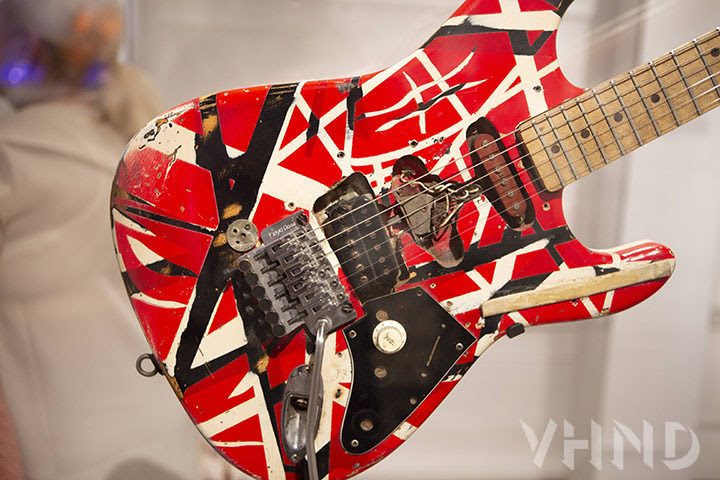I come from a long line of tinkerers. Both my grandfathers had no money through the Depression and World War II, so they had to reuse/repair everything. That was passed along to my Dad who looked with disdain on “new” anything. People make fun of McGyver, but I grew up with him (not as good looking) – we prided ourselves on building things. One of the best was a device to clean spark plugs It was a coffee can, with a small hole where you put the tip of the air compressor hose, directly across from a place to screw in the plug. In between was a block of walnut we machined to create a venturi – sucking sand out of the bottom and blasting the plugs clean. So rather than buying new ones, we could actually use the same plugs for years…
… Eddie was a tinkerer also, driven out of a desire for wonder, and on a budget that was even less than my Grandfather’s. He wanted to blend the rich sound of a Gibson with the vibrato and shape of a Fender… which no one made. No problem – he bought a “scratch and dent” body from Wayne Charvel, and a maple neck – $130. He had ruined a Gibson ES 335 trying to sand it down (flat sander, archtop, fail) so he had a pickup.. but needed to chisel the body away, and mount the pickup at an angle to get the strings to match. Paint – flat black (my Dad’s favorite treatment also..), and then wrapped with tape and painted white… so stripes. Only knob he wanted was volume, which he mounted to an old record cut to shape, and a final ironic twist, a “Tone” knob on it. Done.
For an amp, everybody wanted a Marshall which he saved up for, but if you remember, his tone came at full volume, and Marshall’s at full… hurt. He tried putting the cabinets face down, backwards, but nothing worked, and the head kept blowing up. He found one in the classifieds (remember those?) and bought it. When it arrived, he plugged it in, and nothing came out… until he went back a few hours later and heard a very distorted sound (what he wanted) at a VERY low volume. He didn’t notice – it was a UK amp… and as such was expecting 220V – we use half that in the US. He thought – maybe if I just put a Light switch dimmer in front of his US Marshall it would work? After blowing the fuses on the house a few times to get it sorted, it worked! Now how to take the prototype into a club?
He found there is a device called a Variac – a variable transformer – that will produce the same power waveform but at a different voltage. He realized by “starving” the tubes in the amp, the produced the same sound as “overdriven”, but now at a much lower volume. So he had the rig he wanted – quiet but distorted Marshall tones on a Gibson guitar with a vibrato. One last ingredient – thousand and thousands of hours trying out all different approaches to the instrument… hammer-ons, playing with harmonics, messing with the volume knob to make it sound like a violin. And all without anyone really seeing… in a poor neighborhood in Pasadena California, the music world was about to be introduced to what we now call “The Brown Sound” – because of “brownouts” like California experiences now for other reasons… (This is the story told by him .. worth your time…)
It’s called “tone chasing” – looking for a sound that you have in your head – wondering what it will take to get it. And what our brain wants is to hear something new – never before – and then try to compare it to something. Wonder is taken the time to actually try it out, make mistakes, and learn from it. It is something that we don’t do as much with the ready availability of “information” – doubling every year, and all at our fingertips. Imagine if Eddie had Googled “turning down voltage on tubes” – it would have said, “Don’t do that, it won’t work”. Do you have the Guts to fail – because that is what wonder takes. Oh – and we had a Variac… and the first Christmas tree with lights that were not too bright 😉 I say this every day but PLEASE listen to this… what made Van Halen great. Eruption and 316 … and for the real guitarists – this one when Eddie is older 😉 I actually like this better – he STILL has it..




